Nimravidae
| Nimravids (false sabre-tooths) Temporal range: Early Eocene - Late Miocene
| |
|---|---|

| |
| Hoplophoneus mentalis | |
Fossil
| |
| Scientific classification | |
| Kingdom: | |
| Phylum: | |
| Class: | |
| Order: | |
| Suborder: | Feliformia
|
| Family: | Nimravidae
|
| Subfamilies | |
The Nimravidae, sometimes known as False sabre-tooths, are an extinct family of mammalian carnivores. Although some Nimravids physically resembled the sabre-toothed cats of genus Smilodon, they were not closely related, but evolved a similar form through parallel evolution.
Previously classified as subfamily of Nimravidae, the barbourofelines have been recently assigned to their own distinct family Barbourofelidae (Morlo et al 2004).
The ancestors of nimravids and cats diverged from their common ancestor, from the Caniformia-Feliformia split, in the middle Eocene about 50 million years ago (mya), with a minimum constraint of 43 mya. Recognizable nimravid fossils date from the late Eocene (37 mya), from the Chadronian White River Formation at Flagstaff Rim, Wyoming, to the late Miocene (5 mya). Nimravid diversity appears to have peaked about 28 mya. Most had muscular, low-slung, catlike bodies, with shorter legs and tails than typical of cats.
Nimravids are placed in tribes by some authors to reflect closer relationships in genera within the family. Some nimravids did evolve into large toothed cat-like forms with massive flattened upper canines and accompanying mandibular flanges. Others had dentition similar to felids, or modern cats, with smaller canines. Others did have moderately increased canines in a more intermediate relationship between the saber-toothed cats and felids. Not only were the upper canines shorter than the true saber-toothed cats but were more conical. These are referred to as being False sabre-tooths.
Not only did nimravids exhibit diverse dentition but also showed the same diversity in size and morphology as felids. Some were leopard-sized, others the size of today's lions and tigers, and one with the short face, rounded skull and smaller canines as the modern cheetah.
Classification
- Family: Nimravidae
- Subfamily Nimravinae
- Genus: Dinictis
- Genus: Dinaelurus
- Genus: Dinailurictis
- Genus: Eofelis
- Genus: Nimravides
- Genus: Nimravus
- Genus: Pogonodon
- Genus: Quercylurus
- Subfamily Hoplophoninae
- Genus: Eusmilis
- Genus: Hoplophoneus

The skull of Hoplophoneus mentalis, showing the sabre-like teeth
- Subfamily Nimravinae
References
MICHAEL MORLO, STÉPHANE PEIGNÉ and DORIS NAGEL A new species of Prosansanosmilus: implications for the systematic relationships of the family Barbourofelidae new rank (Carnivora, Mammalia) Zoological Journal of the Linnean SocietyVolume 140 Issue 1 Page 43 - January 2004

